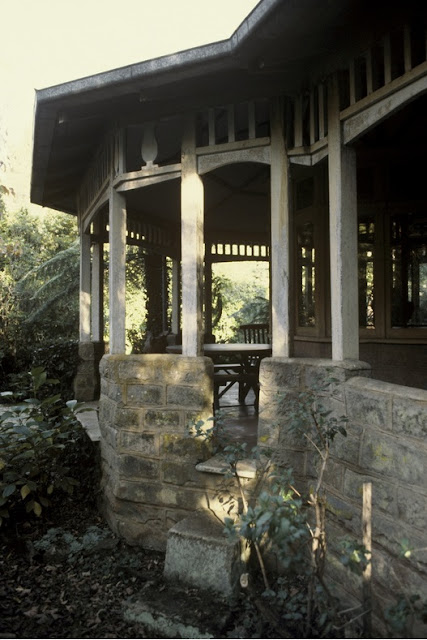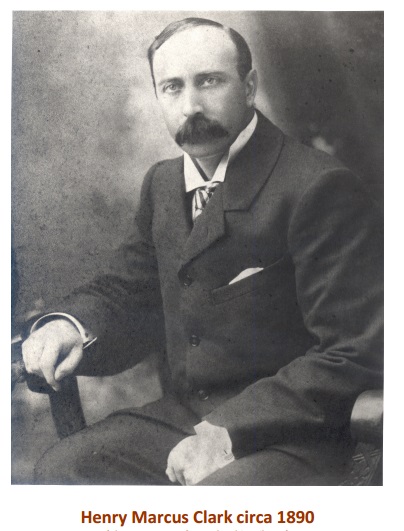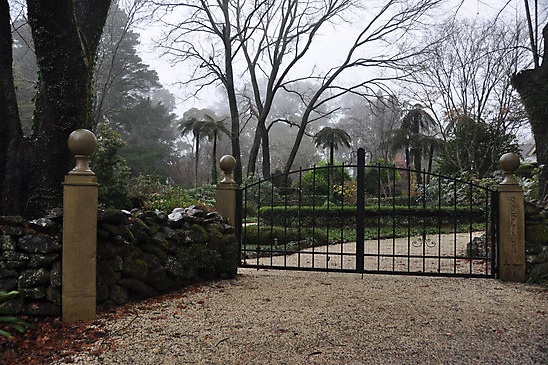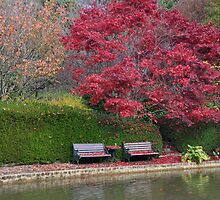Sefton Hall, Mount Wilson NSW
[Previous post: Yalla-Y-Poora Homestead ... Next post: ]
- See also Mount Wilga House
- See also Federation Queen Anne style
Sefton Hall, 17-19 Church Lane, Mount Wilson, NSW 2786
The only non-Victorian style stately house of the eight surviving 'foundation' houses of the Mount Wilson Conservation area: Wynstay, Dennarque andYengo, Bebeah, Withycombe, Nooroo and Sefton.- See also Edwardian Heritage Gardens

Mount Wilson Conservation Precinct
Withycombe, Nooroo and Sefton contain the oldest and best known ornamental tree plantings.NSW State Heritage Register
Table of Contents
 |
| SEFTON HALL, MOUNT WILSON NSW;Photographer: Ross Heathcote Date Photographed: October 1994 |
 |
| Henry Marcus Clark (1859-1913) |
Henry Marcus Clark, the well-known Sydney Retailer, purchased a number of portions of land in Mt. Wilson c.1910-1912 including Beowang. However for his residence he built Sefton Hall (Figure 7) where Balangra (the home of James Dalrymple Cox, the brother of George Henry Cox) had stood,
- the original Beowang building having been moved in two parts one of which became a Billiard Room and the other was later called Sefton Cottage.
- Significantly, Henry Marcus Clark pioneered the introduction of the telephone to Mt. Wilson by having a line laid from Mt. Victoria to Sefton Hall c.1912
 |
| Sefton Hall, Mount Wilson, c 1912 |
Sefton Hall was completed around 1912 as a summer retreat for wealthy Sydney retailer Henry Marcus Clark (1859-1913). Clark had made his fortune from the Marcus Clark & Co. chain of department stores which he had established in 1883. When he bought the Mount Wilson property, then known as Balangra, from pastoralist James Dalrymple Cox in 1909 it included a late nineteenth-century timber cottage with lattice-enclosed verandahs. The cottage now stands within the grounds of Sefton Hall and is known as the ‘billiard room’.
Clark called his new house ‘Sefton Hall’ after the village of Sefton in Lancashire, England where he had grown up. An earlier home in the Sydney suburb of Dulwich Hill had also been named ‘Sefton Hall’.
- Mt. Wilga House was also reputedly designed by the owner Marcus Clark and planned along similar lines to his summer home 'Sefton Hall' at Mount Wilson in the Northern Blue Mountains. Mt. Wilga House was intended to be Marcus Clark's winter home.
The Mount Wilson property sprawls across 20 rooms and is clad in fibro with pressed metal ceilings, though the original corrugated iron roof has been replaced by slate. The original materials were chosen for both their portability and fire resistant qualities.[1]
Photographs from Sydney Living Museums
 |  |
 |  |
Historic Significance

Sefton Hall, its billiard room and garden display both characteristics of the early development of Mount Wilson before 1890 and the sort of twentieth-century development which another generation of the wealthy could bring to the hill-station.
- The property combines a garden which, like Nooroo, retains some of the major trees which were planted in the 1880s and something of the original garden concept, particularly in relation to the The Avenue.
- The property includes a cottage (later a billiard room to Sefton Hall) and Balangra (now Sefton Cottage), built by George Cox’s brother James.
- The survival of part of Belangra as Sefton Hall's billiard room and because of the tree plantings, still has a palpable presence in Mount Wilson.
- Henry Marcus Clark, the founder of one of Sydney's most successful businesses in 1902, was a vigorous and imaginative man who brought a vitality to Mount Wilson that was not without controversy but did not lack signficane at a State level.
- The Anglican church, a particularly successful design in asbestos cement, was built by the Clark family in 1916 on land given by Clark before his death as a memorial to him after his death.
Aesthetic Significance
 |
| Part of old Belangra, now a billiard room in the garden. |
Sefton Hall is of high significance for its selection of materials, particularly the extravagant use of fibrous cement sheeting on a residence of substantial scale and conscious design.
- The design of the residence is a commendable example of the inter-war (Federation Queen Anne) bungalow style featuring multiple gables embellished with asymmetrical screens, generous verandahs, bay windows and beveled glass.
- The separate billiard-room, described as ‘quaint’ by Howard Tanner (Great Gardens, 94) is exceptionally fetching in the front garden. The whole aspect of the property is a heritage asset of State significance.
- Belangra was built in 1880 as a larger holiday residence for J.D. Cox. Note the added gables and trimmings in the Queen Anne idiom to the billiard room; the other part of Belangra is now Sefton Cottage..
Images from the Blue Mountains Library
1. "Wynstay," Mount Wilson
| 2. Beowang, Mount Wilson
| 3. Mount Wilson
| 4. Dennarque, View from the east, Mount Wilson
|
5. Cox Family, The Avenue
| 6. Bebeah, Mount Wilson
| 7. Bebeah, Mount Wilson
| 8. George Henry Cox (1824-1901)
|
The death of Marcus Clark
From about 1910, Henry Clark who had some recurring health problems began to think about retiring.- He put effort into the development of the property at Mt. Wilson. Clark named his new country seat “Sefton Hall” after his former home at Dulwich Hill.
- In 1913, he became seriously ill and specialist physicians were sent up to Mt. Wilson from Sydney to advise on his condition. A decision was made to operate immediately – using the dining room table as an operating platform.
- Clark, did not however, survive the operation. The cause of death was given as pancreatitis and cholelithasis. He was aged only 53.
- The Sydney Daily Telegraph (March 31, 1913) reported an attendance of about 1200 people, “including the deceased’s relatives and 400 employees” at the funeral service. As implied earlier, there was a not inconsiderable overlap between Clark’s relatives, friends, church associates and employees.
- The service was conducted by A.E. Illingworth, Enmore minister, and G.T. Walden. Walden, whose grand portrait stares out of the pages of the Jubilee History had been the dynamic minister at Enmore during its glory years around 1900-1906. In his association with the Clarks, Walden seemed to acquire the role of family chaplain.
- He officiated at family related weddings and funerals long after his time as minister at Enmore. Walden’s comments at the funeral include mention of a letter received from Henry just a few days before his death inviting him to visit.
|
|
|
- Walden’s eloquent eulogy described Henry Clark as a “benefactor to hundreds, and a friend to all” (The Australian Christian of April 17, 1913). Walden went on to say “His shareholders and employees were to him members of a great family. When he died they knew they had lost a real friend as well as a successful general”. Walden supported that statement by reading numerous extracts from letters of bereavement sent by grieving employees. The high level of attendance by company employees at the funeral service (possibly around 50%) bears testimony to the regard with which they held him.

- Concerning Clark’s generosity, Walden said: He gave prodigally to needy ones. One of Sydney’s leading doctors wrote ‘I have come across innumerable instances of his quiet generosity and goodness to others’. He gave liberally to organised charities but the greater part of his giving was direct to the needy ones, mostly anonymously, as he disliked being thanked for anything he did.
- At the time of Henry’s death, Marcus Clarks had expanded into a chain of about 15 stores with 700 employees. It was one of the first of the department stores to realise the benefits of regionalisation. A year or two later, now an official army Chaplain, Walden departed for the Great War.11 The world was about to change - and so was retailing.
- Henry Clark was succeeded by his eldest son Reginald Marcus who learned the trade while managing the Newtown store. Reginald got off to a bad start. While attending his father’s funeral, his home in Stanmore was ransacked by thieves. Under his leadership the chain store reached its apogee. In 1926 - 1928 a new store was erected in Railway Square facing Central Railway - apparently to replace the Flatiron building nearby.
Mount Wilson
Mount Wilson has high state significance because of its unusual development as an Indian-type hill-station for a handful of wealthy businessmen, lawyers and politicians escaping in summer from the climate of Sydney and Newcastle. |
| BISLEY GARDENS, MOUNT WILSON, NSW. by Phil Woodman |
- It preserves to an extraordinary extent the values which these nineteenth-century owners and their resident staff imposed on the striking environment of the basalt outcrop, with its tree-ferns and rain-forest.
- The temptation to create exotic gardens in this lush place was indulged enthusiastically, so that the contrast and the tension between the native and the introduced, the natural and the modified, has created over a century a village of exceptional interest.
- The surviving houses are collectively and individually fine examples of Victorian residential work with Yengo and Dennarque of particular merit. Wynstay, despite the loss of Yarrawa, is the jewel in the crown thanks to the fine suite of outbuildings including the gatehouse, stables and the unique Turkish bathhouse to complement Old Wynstay and the grander inter-war main house of Wynstay.
- Later retreats such as Sefton Hall reinforce the qualities of these early retreats.
|
|
|
| ||||||||
|
|
|
| ||||||||
|
|
|
| ||||||||
|
|
|
|
- A little corner of rural England in the middle of an ancient rainforest with special homes including
Farcry, Sefton Hall, Donna Buang, Sefton Cottage, Dennarque, Campanella, Woodstock, Lindfield Park, Merrygarth, Yengo, Eastcote, Shasta Lodge, and Wynstay.
- Whatever it is, there is no doubting that Mt Wilson is a special spot.
- The locals will tell you that once they get to the hairpin bend on Mt Wilson Rd and drive into the dark forest created by tall trees blocking the sunlight, they know they are home.
- The area is drenched by rain during the summer, creating lush growth that bodes well for an abundant autumn display on Mt Wilson's open garden weekend in Autumn and Spring every year.
- The large, ancient trees enable plenty of space for shade.
- Birdlife is abundant here too, including small birds such as blue wrens.
- "When you are weeding here they come and sit near you. The little birds here are tame. They feel safe, they nest on the ground," Wai says.
| ||||
|
Fronting Marrickville Road at Dulwich Hill, Henry Marcus Clark (1859–1913) had the original property, Sefton Hall, named after the village of Sefton in Lancashire, England where he had grown up.
- Before moving to Sefton Hall in 1890, the family had lived at Newtown.
- They would later have other country residences at Mount Wilga, Hornsby, and another Sefton Hall at Mount Wilson in the Blue Mountains.
- The property was associated with lavish entertainments and fund raising benefits for the local Marrickville Cottage Hospital. For special occasions Marcus Clark always lit the grounds with Chinese lanterns and fairy lamps.
- Sefton Hall was the first private house in Sydney to have a swimming pool
- In the early twentieth century, Sefton Hall was demolished and the land was subdivided. From this subdivision, several blocks of shops were built along Marrickville Road. The shopkeeper in Marcus Clark would have approved as it did give a boost to the retail life of Dulwich Hill.
Further reading:
Marcia A.M. Clark, The story of Henry Marcus Clark and Sefton Hall, Personal publishing Pty Ltd, Sydney, 1985Chapter on Sefton Hall in Alison Halliday & Joanne Hambrett, A passion for place: gardens of the Blue Mountains, Melbourne, Bloomings Books, Melbourne, 2011
- ^
Caroline Simpson Library & Research Collection, Photograph Ross Heathcote, (c) Sydney Living Museums -
http://sydneylivingmuseums.com.au/documenting-nsw-homes/sefton-hall


































No comments:
Post a Comment